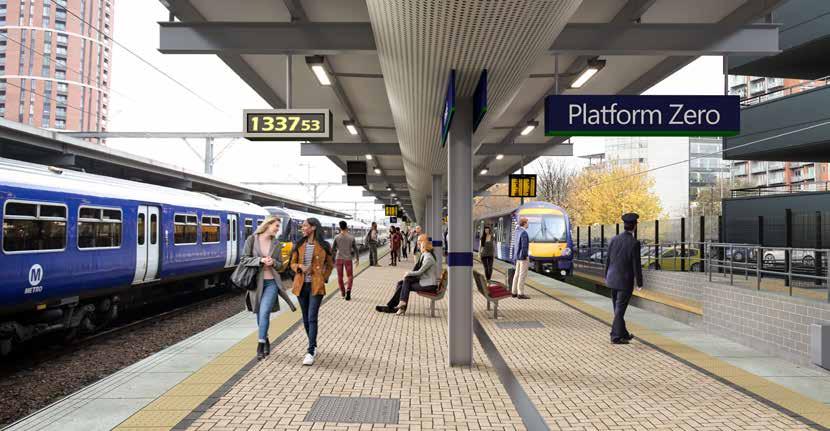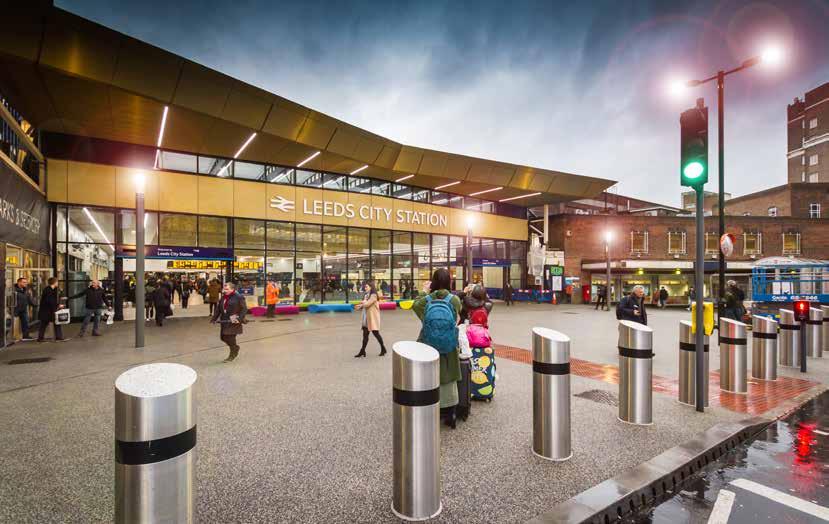
10 minute read
Growing Pains
GRAEME BICKERDIKE
ALL PHOTOS: FOUR BY THREE
Leeds is vibrant and thriving, its cityscape undergoing perpetual transformation as glass and steel are jemmied into gaps between historic buildings - industrial, commercial, civic - many of which are, in turn, evolving for modern city living.
London, Birmingham, Manchester, Sheffield, Nottingham, Newcastle, Glasgow: most of our great urban centres benefit from underground, tram or light rail networks. But not so Leeds. The aspiration to develop one here is longstanding; however, until decisionmakers find a way forward, the railway must shoulder the burden.
The city’s station has seen its own changes over the past 60 years. It was substantially rebuilt in 1967, when 500 trains per day typically served it. Between 1999 and 2002, the ‘Leeds 1st’ project introduced five new platforms and daylight into the train shed. Additional tracks were laid on the western approaches, whilst signalling control was transferred to York. In 2016, an eye-catching new entrance offered easy access from the residential and business district emerging on the station’s south side, beyond the river which it spans.
Passenger numbers have doubled over the past 20 years; 31 million people now use Leeds station annually and daily train numbers exceed 1,250. It’s the busiest in the North, ranking 12th nationwide. And, with growth forecast to continue, the pressure is on to increase capacity and improve the customer experience.
Broader vision
Time had taken its toll on the station’s southern concourse, becoming tired and gloomy - a far cry from the iconic gateway to which Leeds might reasonably aspire. Within its roof space, redundant assets and legacy asbestos required removal in a safe, controlled environment. Encapsulating it without impacting on passenger flows would involve the installation of a full scaffold crash deck, the estimates for which bent the available budget. Value engineering was called for. With the roof already leaking and approaching the end of its serviceable life, options were developed for its

replacement. The design, produced by TSP Projects, made best use of the existing support structure - which remained in good condition - although some extra steelwork was needed to meet both structural loadings and current security requirements around blast resistance.
The safest and most economical roof solution has involved the use of ethylene tetrafluoroethylene (ETFE) - a material already familiar to any traveller who’s prone to looking upwards; the lightweight system introduces natural light into a number of our major stations. Mounting the ETFE panels above the existing roof trusses creates a greater sense of space, whilst the two bays closest to the entrance are raised by a further 1.2 metres to give the new station frontage more presence in the streetscape.
Ground force
Work to install the scaffolding got underway in November 2018, remaining in place for ten months until the UCI Road World Championships brought cycling fans to Yorkshire - a fixed point on the timeline which imposed a demanding programme. Contractor Colt Construction had 90 operatives dotted around the site during peak periods. A 60-tonne crane, located in front of the station, assisted with the heavy lifting during demolition of the old canopy.
Presenting the greatest technical challenge was the vast structure of Victorian brick arches on which Leeds Station is built. The scaffold design had to take account of loading from the crash deck, top hat, any snow that might fall on it and the city’s notorious windstreams. A 3D model was produced to ensure its two-metre-square support towers were located directly over the brick piers, so as not to apply point loads on the arches. Conveniently, the subterranean structures are arranged diagonally, driving the adoption of a diamond grid pattern which better accommodated the critical passenger thoroughfare between the train shed and north concourse.
Supplied by Vector Foiltec, the ETFE came in sheets, each comprising three layers of foil, and were inflated to form air pressure stabilised ‘pillows’ after installation into their frames. Despite being less than five per cent of the weight of comparable glazing, they can take the loading of a small car, not that they’re ever likely to!
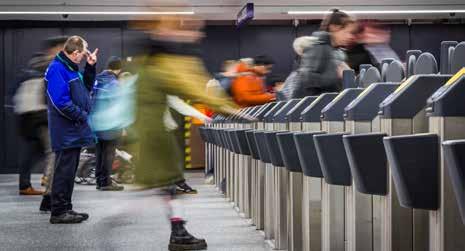
The extra mile
With a team already in place to deliver this project, the opportunity to make further enhancements around the concourse was not missed.
By removing three retail units, a straight ticket gate line has been introduced, overcoming the problems of the old dog-leg layout which reduced queuing space on the platform side. This had been a persistent cause of passenger complaints by virtue of the bottleneck it created at peak times. The station’s customer information screens are now located above the ticket gates, moved from a position where they conflicted with passenger flows.
The south concourse is now decluttered, save for a seating area and the travel information centre which acts as a clear focal point. Its former home has been
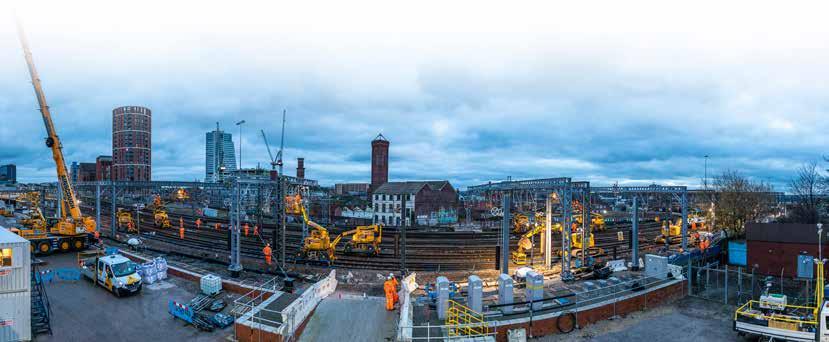
allocated to a Changing Places facility, opening later this year and offering a shower, hoist and changing bed for those travelling with severely disabled passengers. The public toilets have also been fully refurbished, whilst work continues on those serving the platforms. Out front, more of New Station Street has been pedestrianised to improve the approach environment - an element funded by the West Yorkshire Combined Authority. Previously, this area was constrained by two roadways and a low canopy, cantilevered out by as much as 15 metres; generally, it felt a bit grim. With the new canopy much higher, the space is refreshed, brighter and more welcoming, revealing views of the symmetrical façade. Matt Ramsden, who managed the project for Network Rail alongside colleague Adam Showell, has been gauging reactions from station users. “It’s all been positive,” he reflected. “The main comment seems to be that there’s so much natural light.”
Platform change
This multi-million-pound spend on the station’s public realm complements a bigger scheme to increase train capacity. The last major revamp here fuelled its own growth, with demand since outstripping what the models had forecast.


Andy Martin, Network Rail’s programme manager, is part of a team responsible for a £161 million investment which will see an additional bay platform opened. “It’s also about changing the functionality of the layout to make sure we can get more trains in and out of the existing platforms”, he noted. As a result, the more complex aspects involve associated works to the track, signalling and overhead line infrastructure.
Leeds currently has six through platforms and 11 bays, six of which handle traffic on the ‘north-west’ routes to Harrogate, Ilkley, Bradford and Skipton. The new Platform 0 will sit alongside these on the north side of the station, served by a new running line from the western throat.
Team building
As you’d expect, it’s been a long time in the planning, with notable landmarks passed along the way. The area’s signalling control had been transferred to York IECC in 2001; however, with the system no longer supported by its installers, Resonate performed a full upgrade in December 2018 to accommodate upcoming expansion. October saw the installation of two overhead-line gantries spanning all six tracks on the station’s western side; some signalling power equipment was also relocated.
Initial feasibility work around train services was carried out by Tata between 2013 and 2015; they optioneered track layout designs to achieve improved functionality. But one challenge of today’s railway is the fluid aspirations of franchise holders. Consequently, the proposed approaches to Platforms 4-6 are currently under review.
Overall, the layout around the northern bays will be better aligned to meet short and medium-term franchises and service aspirations; it will also bring benefits to train performance with improved flexibility. A new crossover between
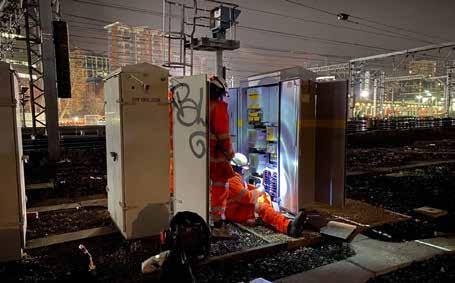
Platforms 1 and 2 will enable parallel working - more efficient movement in and out, overcoming the need for services to fully clear the western throat before others work back in.
Helping to manage safely the implications and constructability of any changes are the engineers and planners within the project’s supply chain. There are three key collaborators within the huband-spoke contract: Alstom - responsible for the signalling and associated power works, Buckingham Group - undertaking the civils and platform activities, and the Central Rail Systems Alliance - a partnership between Balfour Beatty, TSO and Atkins - handling the track, OLE and additional E&P elements.
A site compound has been established for the works in the station car park, part of which will be taken up by Platform 0. It’s been closed to the public since last spring, with the loss of around 400 spaces. For the time being, the adjacent multistorey is dedicated for use by operational staff from the train companies.
Peak performance
Christmas is a time when the railway family comes together to relish the priceless gift of a train-free network. At Leeds, a 450-strong workforce sacrificed time with their other families to deliver an extensive programme of works which had been refined over the preceding 12 months.
The core package included the renewal of three point-ends and installation of two new ones - which aren’t in service yet - as well as commissioning and wheels-free testing two of Alstom’s computer-based Smartlock interlockings, to be operated from Network Rail’s York Rail Operating Centre. Minor changes were made to the power supply. Additionally, overhead line equipment was fitted to six new gantries, allowing the removal of seven redundant gantries which stood in the way of the line into Platform 0.
Responsibility for safely managing the overall site was vested with Buckingham as principal contractor. From a civils perspective, the firm regauged 60 metres of Platform 3 and reduced the length of Platform 2 by 30 metres to make way for the new crossover; resurfacing work was also carried out.
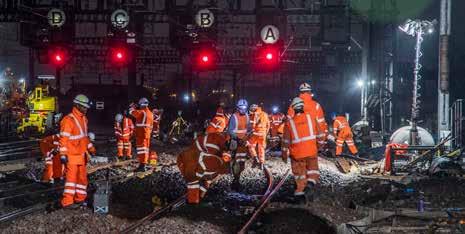
All lines were blocked for 54 hours, during which time the track and signalling work was completed, except for tamping. Every last drop of value was wrung from this period. Despite unexpectedly encountering buried concrete and the need to undertake minor on-site modifications to the S&C, handback occurred six minutes early.
From 04:10 on 27 December, the possession was scaled back to encompass just Platforms 1-5 plus the A & B lines, an arrangement which continued until 04:00 on 30 December. With the remaining signalling, OLE, civils and track works completed, handback was more comfortable, taking place over four hours ahead of the published time.
Moving forward
2020 brings a number of additional stages towards the scheme’s culmination next Christmas, an end-date driven by the need for more changes to the signalling control system and interlocking. Thereafter, Platform 0 will be commissioned. In the meantime, Platform 1 - on the other side of the island - and its canopy have to be rebuilt to meet the new track alignment. Despite this intervention, it will mostly remain open throughout the year so as not to unduly disrupt Northern’s services. However, it won’t be in its existing form; to create a safe working area for demolition and reconstruction, the platform will be shortened to 130 metres and, for several periods from May, trains will arrive at a temporary scaffold structure on the other side of the Platform 0 track. This will require careful operational management, as the line won’t be electrified.
When it comes to predicting the future, the only certainty is uncertainty. Who could have foreseen the motor car’s potential demise 30 years ago or the railway’s confident re-emergence from the doldrums? There will be more to come as climate crisis imposes a greener agenda, like it or not. In the 2020s, we’ll end up putting back more of what we discarded in the 1960s.
Platform -1 anybody? It’s all change at Leeds.
